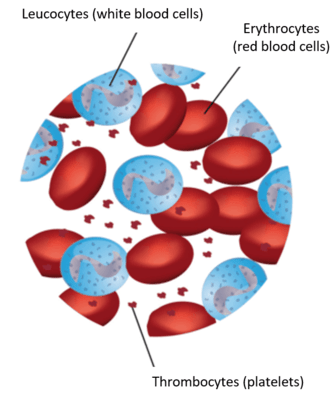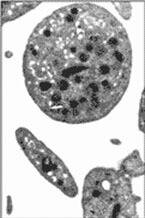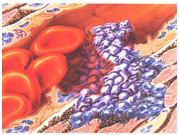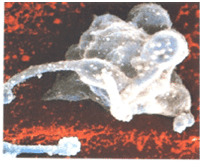Blood flows through our blood vessels (veins and arteries). Blood contains fluid and blood cells. The fluid (plasma) consists of water, salts and proteins. Blood cells can be divided into:
 |
Red blood cells (erythrocytes) for transporting oxygen and carbon dioxide White blood cells (leucocytes) to protect our body against viruses and bacteria, but also to clear out dead cells and damaged tissues Platelets (thrombocytes) for sealing damaged blood vessels, also referred to as blood clotting
|
Platelets are offshoots of large cells (megakaryocytes) in the bone marrow. At rest, they are round, flat discs, 3 micrometres thick and 10 micrometres in diameter. When activated, they change from flat discs to spheres with long tentacles, making it easier for them to bind to each other and to the surrounding structures. Normally people have between 150 and 350 million platelets per millilitre. They remain in the blood for between 7 and 10 days, after which they are broken down mainly in the spleen, but also in the liver.

An electron microscopic view of platelets. A variety of functional organelles and vesicles can be seen in the platelets.
Platelets have proteins on their surface that can bind to damaged vessel-wall structures. When they bind to these, they are activated and secrete coagulation-promoting substances. This also activates and binds platelets in the immediate vicinity, creating a platelet clot. The formation of a platelet plug and additional strengthening by proteins from the blood serum, such as fibrin and Factor VII, as well vasoconstriction (narrowing of the blood vessels) are important for proper hemostasis (stop the bleeding).
When the inner lining of a bloodvessel is damaged, platelets are activated and the coagulation (clotting) process begins.
 |
 |
 |
Images of an activated platelet.
An electron microscopic image of an activated platelet. Its tentacles allow it to bind more closely to the vessel wall or to other platelets.
An activated platelet. This image shows that various substances are secreted, so that surrounding platelets also become more active and help with the clotting process.

Tel. 085-1303570 | E‑mail info@itp‑pv.nl | Bank 1 NL69RABO0345603702 | BIC RABONL2U |Bank 2 NL91ABNA0401810461 | BIC ABNANL2A | KvK 17156005 | ANBI 8135.93.372


